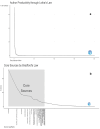Nano-enhanced immunity: A bibliometric analysis of nanoparticles in vaccine adjuvant research
- PMID: 39539151
- PMCID: PMC11572201
- DOI: 10.1080/21645515.2024.2427464
Nano-enhanced immunity: A bibliometric analysis of nanoparticles in vaccine adjuvant research
Abstract
This study analyzed the growth, collaboration, citation trends, and emerging topics in nanoparticle-based vaccine and adjuvant research (NVAR) from 1977 to 2023, using data from the Scopus database. The field showed a steady growth rate of 7.53% per year. Leading researchers Jaafari, M.R. and Alving, C.R. contributed significantly to the field, with 24.22% of publications and 38.92% of total citations coming from the United States. International collaboration was very strong, particularly between the US, UK, Germany, China, and France. Key research topics include nanoparticles, immunotherapy, COVID-19, and vaccines with a focus on SARS-CoV-2 and malaria. Emerging topics include vaccine adjuvants, mRNA, and neutralizing antibodies. This study emphasizes the importance of ongoing collaboration and interdisciplinary efforts to advance the field of NVAR.
Keywords: COVID-19; Nanoparticle-based vaccine; adjuvant research; collaboration; immunotherapy.
Conflict of interest statement
The authors declare that there are no conflicts of interest, either financial or non-financial.
Figures










References
-
- Abusalah, M.A.H., Chopra, H., Sharma, A., Mustafa, S.A., Choudhary, O.P., Sharma, M., Dhawan, M., Khosla, R., Loshali, A., Sundriyal, A. and Saini, J., 2023. Nanovaccines: a game changing approach in the fight against infectious diseases. Biomed & Pharmacother. 2023;167:115597. doi:10.1016/j.biopha.2023.115597. - DOI - PubMed
-
- Tursi NJ, Xu Z, Helble M, Walker S, Liaw K, Chokkalingam N, Kannan T, Wu Y, Tello-Ruiz E, Park DH, et al. Engineered antibody cytokine chimera synergizes with DNA-launched nanoparticle vaccines to potentiate melanoma suppression in vivo. Front Immunol. 2023;14:1072810. doi:10.3389/fimmu.2023.1072810. - DOI - PMC - PubMed
Publication types
MeSH terms
Substances
LinkOut - more resources
Full Text Sources
Other Literature Sources
Miscellaneous
